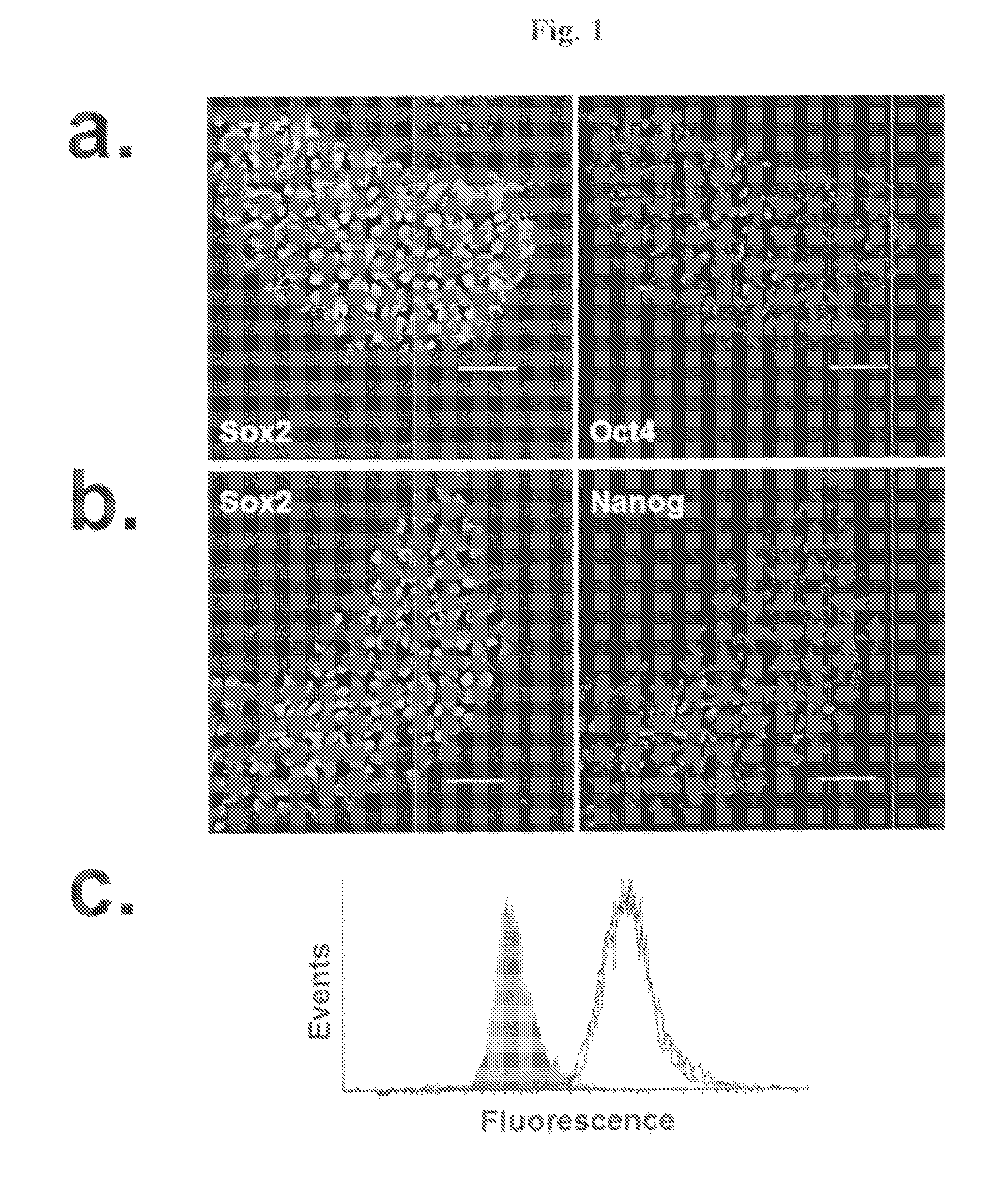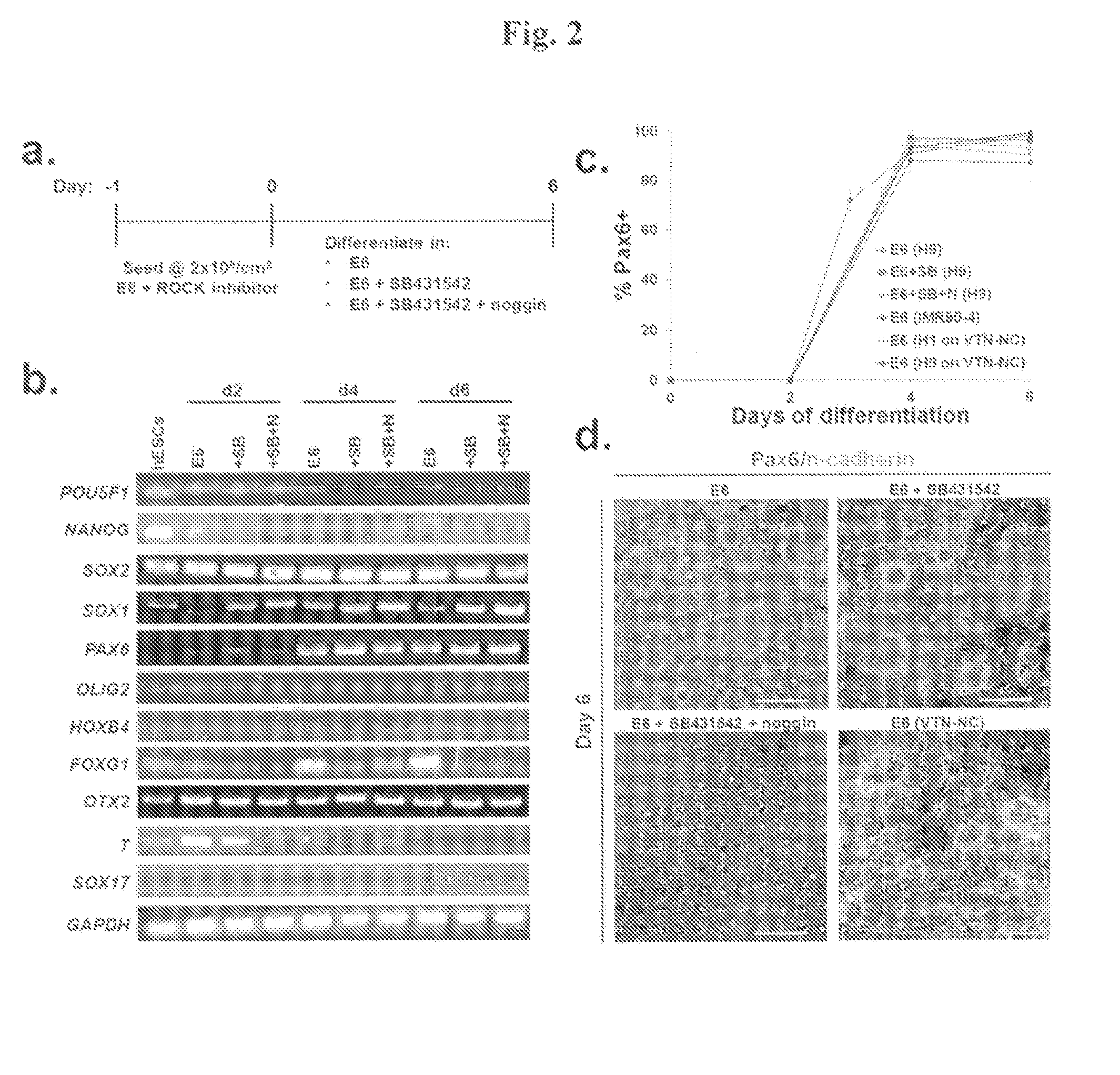Simplified Compositions and Methods for Generating Neural Stem Cells From Human Pluripotent Stem Cells
a composition and stem cell technology, applied in the field of simplified compositions and methods for generating neural stem cells from human pluripotent stem cells, can solve the problems of limiting clinical utility, undefined or undesired or expensive culture components, and inability to meet the needs of hpsc neural differentiation protocols to da
- Summary
- Abstract
- Description
- Claims
- Application Information
AI Technical Summary
Benefits of technology
Problems solved by technology
Method used
Image
Examples
example 1
Materials and Methods
[0101]Maintenance of hPSCs
[0102]hPSCs were obtained as frozen vials banked under feeder-independent conditions in mTeSR1 medium (STEMCELL Technologies). hPSCs were then thawed and cultured directly into E8 medium consisting of DMEM / F12 (Invitrogen), 64 mg / L ascorbic acid (Sigma), 543 mg / L sodium bicarbonate (Sigma), 14 μg / L sodium selenite (Sigma), 19.4 mg / L insulin (Sigma), 10.7 mg / L transferrin (Sigma), 100 μg / L FGF2 (Waisman Clinical Biomanufacturing Facility, University of Wisconsin-Madison), and 2 μg / L TGFβ1 (Peprotech). hPSCs were maintained on Matrigel® (BD Biosciences) or recombinant vitronectin peptide (VTN-NC) as described in Chen et at (2011), Nature Methods, 8:424-429. Cell lines used in this study were H9 hESCs (passage 25-45), H1 hESCs (passage 28-36), and IMR90-4 iPSCs (passage 26-40). For some comparative experiments, H9 hESCs were maintained on irradiated mouse embryonic fibroblasts (MEFs) in standard unconditioned medium: DMEM / F12 containing 20...
example 2
hPSCs Maintained in E8 Medium Undergo Rapid Neural Specification in E6 Medium Under Defined Conditions
[0108]Differentiation to neuroepithelium can be conducted under adherent conditions or using embryoid body (EB)-based methods (Pankratz et at (2007), Stem Cells, 25: 1511-1520. EB-based methods can take up to 17 days to yield definitive neuroepithelium, and controlling EB differentiation in a reproducible, scalable fashion is a challenging prospect (see, e.g., Bratt-Leal et at (2009), Biotechnology Progress 25: 43-51. Recent reports in adherent differentiation have demonstrated more rapid neuralization using small molecules and recombinant proteins, yielding >80% neuroepithelium after 11 days (Chambers et at (2009), Nature Biotechnology, 27:275-280. The original protocols used SB431542 (an inhibitor of TGFβ signaling) and noggin (an inhibitor of bone morphogenetic protein (BMP) signaling), and follow-up protocols (e.g., Kim et at (2010), Stem Cell Reviews 6:270-281) have replaced no...
example 3
Directed Neural Differentiation Under Completely Defined, Xeno-Free Conditions
[0109]All experiments described above in Example 2 utilized Matrigel® as the culture substrate during maintenance and differentiation. Thus, to construct a completely defined system, we maintained H1 and H9 hESCs in E8 medium on recombinant vitronectin peptide (VTN-NC) and then differentiated the cells in E6 medium as described above but replaced Matrigel® with VTN-NC. Differentiation on this defined surface yielded 90±1% PAX6 cells from H1 hESCs and 99±1% PAX6 cells from H9 hESCs after 6 days (FIG. 2c), and neural rosette formation was also observed under these conditions (FIG. 2d and FIG. 6). Thus, the effectiveness of the differentiation procedure does not depend on the use of Matrigel® as a substrate. Overall, this procedure yields highly pure definitive neuroepithelium under completely defined and scalable adherent conditions.
PUM
 Login to View More
Login to View More Abstract
Description
Claims
Application Information
 Login to View More
Login to View More - R&D
- Intellectual Property
- Life Sciences
- Materials
- Tech Scout
- Unparalleled Data Quality
- Higher Quality Content
- 60% Fewer Hallucinations
Browse by: Latest US Patents, China's latest patents, Technical Efficacy Thesaurus, Application Domain, Technology Topic, Popular Technical Reports.
© 2025 PatSnap. All rights reserved.Legal|Privacy policy|Modern Slavery Act Transparency Statement|Sitemap|About US| Contact US: help@patsnap.com



